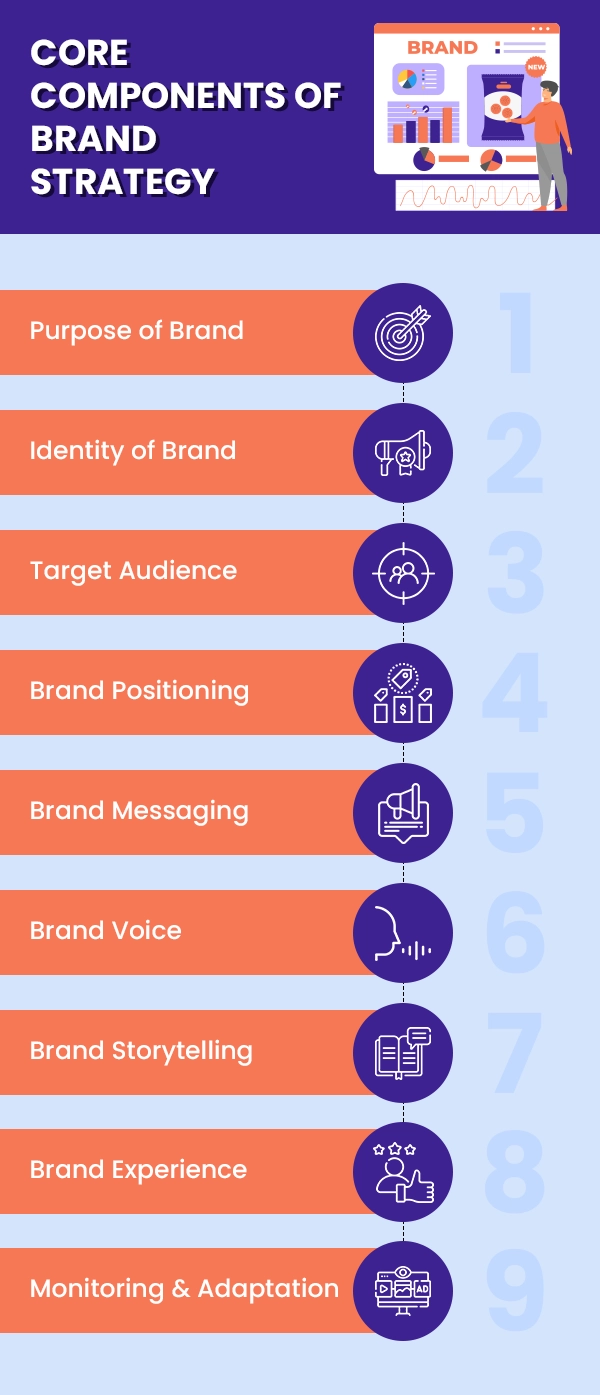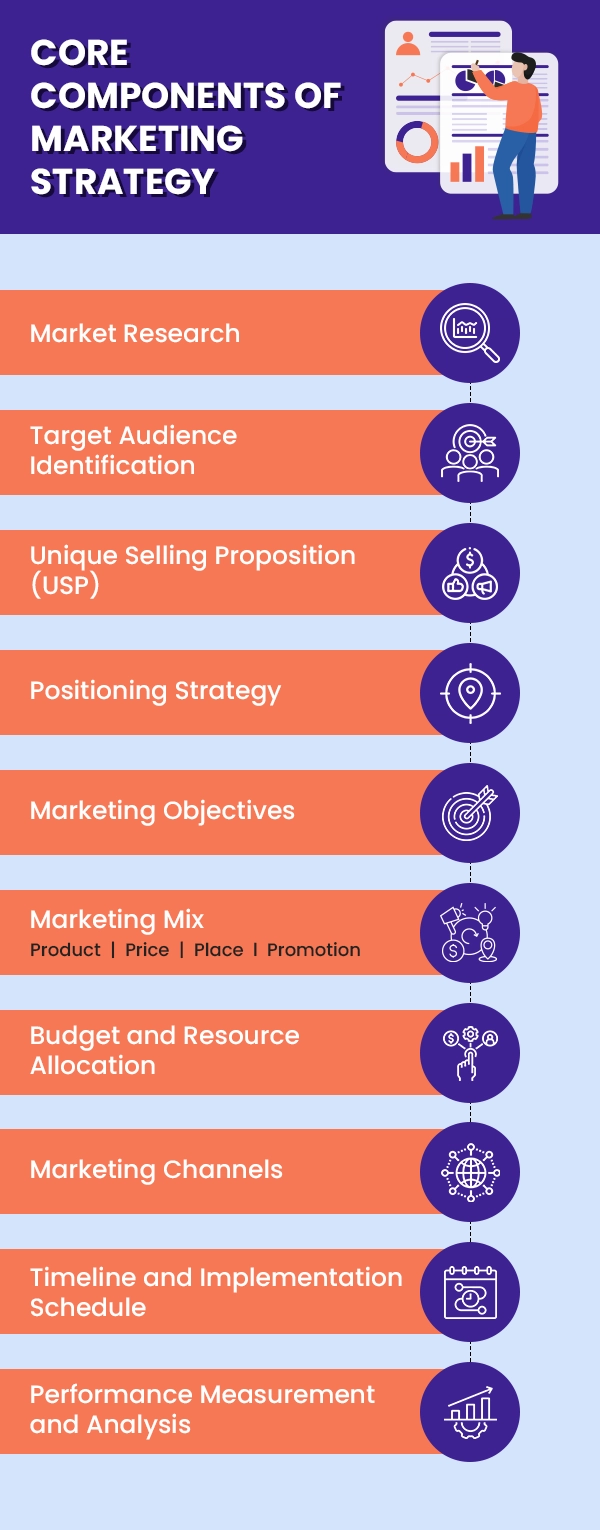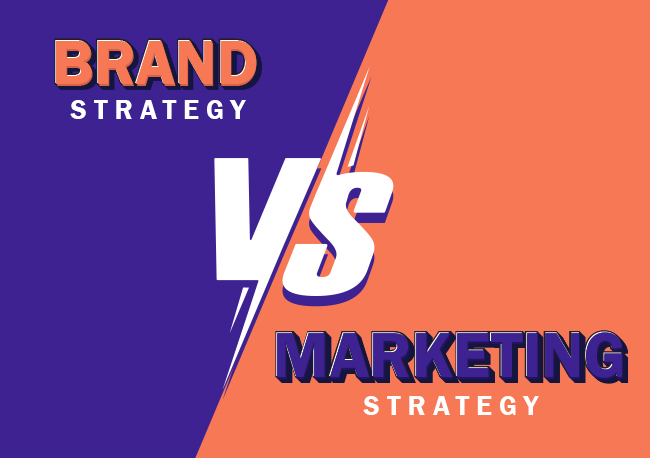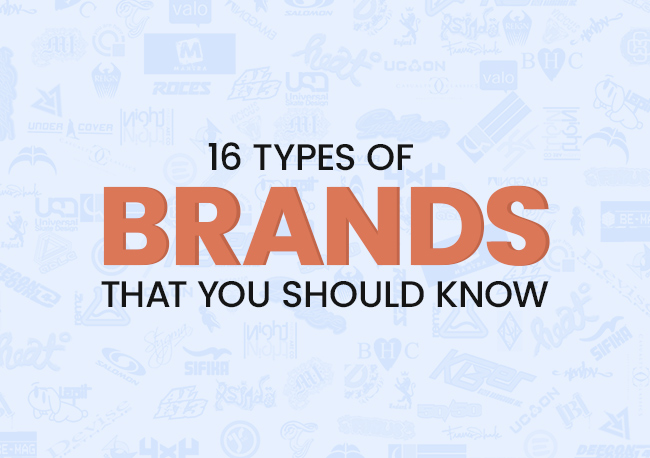| Getting your Trinity Audio player ready... |
We often make a purchase depending on the quality and brand rather than the price. Why is that?
Because we trust the brand to provide great satisfaction even if it comes at a higher price, this is how brands build their businesses on trust. Higher the goodwill, the more successful the brand will be.
In order to differentiate between branding and marketing strategies, you must first understand what each means and how they may be used effectively in your business.
Now, the first question that enters your mind is, what is a brand?
We believe the design, logo, or color scheme is how you recognize a brand. Isn’t that right?
Well, that is partially correct. However, the company’s connection with the people makes it prominent and trustworthy.
The logo, design, and color you choose for your product/service become the face of your brand. And marketing is one of the ways you spread the word about your business.
In this blog, we will dive further into the details of branding and marketing strategy and everything you need to know to build a successful business.
What is a Branding Strategy?
To build a business, you must first plan your branding strategy. As you know, a brand strategy is an essential component of your business. A strong brand strategy establishes your company’s identity, focuses on your long-term objective, and helps determine your strongest qualities and shortcomings.
The key to a successful business is its brand strategy.
Let’s outline the fundamental elements of a branding strategy and how they will support the development of your company to strengthen the foundation.
Also Read: Digital Marketing Strategies For Catering Business
➢ Purpose of Brand
The magic happens when your audience starts connecting with the brand. This takes place when a brand is clear about the purpose behind its product or service, how it can benefit the customers and the sentimental value it represents.
➢ Identity of Brand
Brand identity is the term used to describe the distinguishing characteristics of a brand, such as its color, logo, and design. Creating a unique logo with a logo generator enhances brand recognition. Your brand identity reflects the audience’s association with your product/service. For long-term success, it is essential to have an authentic brand identity.
It reflects a company’s confidence and strength in accomplishing its ultimate objective.
➢ Target Audience
The secret to attracting a substantial target demographic is identifying the needs, developing a product, and eventually selling. This will help your brand identify the primary issues your target audience is struggling with and strengthen their psychological bonds with the brand.
Also Read: Difference Between Target Audience And Target Market
➢ Brand Positioning
Brand positioning refers to the distinctive characteristic of a good or service that is connected with the brand as a whole. Businesses employ the brand positioning strategy to stand out from their competitors and increase awareness of their products.
You’ll know a company’s brand positioning strategy is effective when you start seeing a product as the only answer to an issue.
An effective brand positioning strategy is one that is created with the needs and desires of the target audience in mind. Your target market is who you serve, and when they think of buying a product, it should be yours!
How is that even possible?
When you consider your customers’ wants, you build loyalty among them and provide your brand with a higher value in the eyes of those who believe your goods are superior to those of your competitors.
And when you can create this difference in product superiority, you have created a space for your brand to thrive in the market.
➢ Brand Messaging
Brand messaging is the idea of how your business appears and the principles it upholds are communicated to the audience. Additionally, it enables communication through the tone of voice. A tagline or slogan can be used to communicate the essence of your company. It determines how people will associate with your brand.
Let’s use the brand Dove as an example. A bird, which is a symbol of freedom and love, serves as the brand’s logo.
The brand’s voice is perceived as having a compassionate quality that encourages customers to have confidence in themselves. They sell their products through unique campaigns that promote not just beauty but also self-confidence and self-love.
The brand’s ability to remain distinctive and committed to its principles is made possible by this crucial component of communication through the brand message.
➢ Brand Voice
Imagine your brand as a person and your voice as the personality you carry. This will help you learn about brand voice. How you communicate through social platforms tells a lot about how you perceive things and your ideology.
This is similar to your brand. Your brand voice is how your company appears across all communication channels. The style, integrity of words, tone of voice, and messaging effectively convey your brand voice.
➢ Brand Storytelling
Everybody has a story to tell, but only you can make it compelling. Storytelling is an art, and not everyone is an artist.
The more authentic and transparent you are, the more people will be able to resonate. You can tell if your brand is successful when you can emotionally connect with your customers by sharing your values and beliefs.
When you reveal your brand’s core values and goals, you create a relationship with your target audience. Your story is what the users will resonate with. Be genuine and allow them to relate to your brand to develop enduring brand loyalty.
➢ Brand Experience
We’ve all heard the phrase, “The first impression is the last impression.” When it comes to your consumers, you must create an excellent first impression that will impact their lives and make them feel valued.
When a customer engages with your brand, the entire interaction until the customer purchases the good or service is considered the brand experience. The smoother the process, the more pleasant and memorable it is for them to stay connected.
When you have a brand that caters to the needs of your customers, every step is important.
With constant and persistent efforts from the brand, the consumer develops a strong perspective about the experience that endures throughout the brand’s journey. Make sure it’s satisfying!
➢ Brand Monitoring & Adaptation
Aren’t you a little intrigued to hear what your clients have to say about their interactions with your company?
Brand monitoring and adaptation is a strategy of checking your social media presence and generating an authentic and transparent consumer viewpoint that strengthens the company’s image.
Establishing a firm is challenging, especially with continuous shifts in the industry. Your business must monitor your brand’s performance across various social media platforms.
By keeping track of where your brand is mentioned, you can evaluate your progress and decide whether you’re on the right track or need to tweak your plans considerably.
Let’s have a recap of what we learned about the components of brand strategy with an infographic below:

Also Read: 15 Best Websites For Entrepreneurs
What is Marketing Strategy?
After determining your branding strategy, developing your marketing strategy is a crucial step.
A marketing strategy is converting your prospects into your target consumers by comprehending the market’s and customer’s needs and selecting a niche to address their issues.
These tactics are achievable short-term objectives that can assist you in accomplishing your long-term business objectives.
Every company’s marketing strategy is unique, just like the business itself. You must understand your business’s requirements, goals, and assets, as well as your brand’s strengths and weaknesses, to develop your plan. Here are some essential components to consider when creating a marketing plan.
➢ Market Research
We have all been in a situation when, before making an investment in a product or service, we compared brands, evaluated prices, and made decisions based on each option’s cost, value, and availability.
It works similarly for marketers! They must ascertain the demand for their services and the type of audience willing to invest before presenting their goods and services.
For example, in the wine market, marketers need to analyze consumer preferences such as whether they prefer red, white, or sparkling wine and at what price points, in order to effectively position their products and marketing campaigns.
Simply put, market research is gathering, examining, and interpreting data based on your studies. Market research is created by keeping up with market trends, the demand for products/services, and market conditions.
➢ Target Audience Identification
After conducting a market analysis, the next stage is to ascertain whether your goods or services are intended for a particular market or are accessible to everyone.
Let’s use an example to grasp this better:
A dessert-serving bakery for those who enjoy sweets. Sounds delicious? Now, sweet tooth people can be considered their target audience. However, the target market shrinks to a niche when the same bakery offers only sugar-free desserts for people who have diabetes but crave sweets.
This shift in the size of the customer base is called identifying your target audience. Identifying the ideal consumer will help you create an optimal target audience and secure high revenues.
Also Read: Types Of eCommerce Websites And Models
➢ Unique Selling Proposition (USP)
How will your customers identify your goods and services from your competitors?
After conducting market research and determining your target audience, you should have a good idea of what your customers want and expect from your business. There is no doubt that the products and services offered by your brand will be distinct from those of your rivals. That is your unique selling point.
The company’s unique selling proposition (USP) enables the product to reach the target audience without worrying about competitors.
The firm’s unique selling proposition not only makes it stand out in the marketplace but also helps define the company’s mission and vision, which is the only reason you began it in the first place.
➢ Positioning Strategy
A positioning strategy is a plan of action used to enhance a brand’s perception in consumers’ minds and demonstrate how it is distinct from its competitors.
Imagine the local store you visit to get the necessary supplies for cooking on a daily basis. You can’t find the ingredients you need when you’re in the mood to make something special one day.
Because of the scarcity of resources, you decide to start a business selling hard-to-find items in your locality. We refer to it as a gourmet store. The sole purpose of this store is to store and provide high-quality products to people who love to cook fancy meals.
This gourmet shop is the unique feature that determines why your clients prefer you over your competitors. This is your brand positioning strategy and how to set yourself apart from the competition.
➢ Marketing Objectives
Marketing objectives are rules outlined before beginning the marketing campaign.
This set of rules assists you in accomplishing the primary goals necessary to achieve the ultimate objective.
The SMART technique should be used to achieve your marketing objectives:
S- Specific goals that may be accomplished and bring your firm closer to its ultimate purpose
M- Measurable progress enables the company to evaluate goals in light of your progressive successes,
A- Attainable goals are simpler to manage than lofty aspirations that seem incredible but are impossible to realize.
R- Relevant objectives that advance the company’s ultimate objective are essential and must also align with the long-term goal.
T- Time-based deadlines must also be met to ensure the progress follows the schedule.
Also Read: Top Industries That Can Benefit From SEO In 2023
➢ Marketing Mix
The marketing mix comprises four major elements: product, pricing, place, and promotion. When combined, these four components are used to set your brand apart from the competition.
Let us look further into each of these elements:
- Product: Anything you offer for sale to your target audience qualifies as a product, including both goods and services. It is vital to provide solutions to already existing consumer needs to boost your profits and customer loyalty.
- Price: The cost of the goods and services sold. The product’s success is directly influenced by its pricing. To fix the right price while marketing a product/service is necessary to attract your target group of customers.
- Place: To market your goods, you need a suitable location. The place is where you sell the goods and services you provide, whether online or offline, through a distribution channel, or in a private shop.
- Promotion: After successfully determining the product’s price and place, the next step is to promote your product in the market. The promotion can be done through social media platforms, PR, marketing plan proposals, and many other ways. It is not only a technique to sell your product but also a way to increase your revenue.
This combination of marketing techniques is a collection of strategies a firm can employ to generate business and achieve its objectives.
It serves as a guidance when developing a marketing strategy for your firm and serving your target audience. Your daily decision-making process can also incorporate these factors.
Also Read: Which Businesses Benefits From Local SEO Practices?
➢ Budget and Resource Allocation
Budget and resource allocation is one of the most critical planning stages. Let’s examine each of them separately.
A budget allocation is a financial plan to protect your company’s revenue and expenses. A budget is established for every expense the business incurs to establish a margin that shouldn’t exceed the allotted sum.
Allocating resources includes things like labor, raw materials, etc. This procedure involves allocating, obtaining, and monitoring the estimated resources until the task is finished.
➢ Marketing Channels
Marketing channels are a means by which companies interact with their target audience via a platform, whether online on social media or offline.
Digital advertising, influencer marketing, events, search engine optimization, content marketing, offline word-of-mouth marketing, and conventional methods using print and media are just a few of the wide range of marketing channels available.
Regardless of any advertising technique you choose, it will help your business generate leads, build brand recognition, increase sales, and attract customers.
Also Read: How Is Ranking Different When Comparing PPC Vs SEO?
➢ Timeline and Implementation Schedule
You developed a marketing strategy for your business, but how can you be certain that it works and that all goals are met?
You need a timeline and an implementation schedule to accomplish this. You may now be wondering what an implementation schedule and timetable are!
Don’t fret. Let’s decode this.
Once you’ve developed a marketing strategy, you must put it into practice to turn your ambitions into a reality. It serves to identify the goals and demands necessary to reach the target.
Each task on the agenda has a deadline, and to get through it, you must adhere to a timeline, follow a schedule, and monitor your progress.
➢ Performance Measurement and Analysis
Now that you’ve set a deadline for each task along with monitoring your progress, the next step is performance management and analysis.
Wondering how to accomplish that?
After determining your goal and giving yourself a deadline, you must evaluate the task’s efficacy and efficiency.
It will help in determining both areas for improvement and areas for progress.
It also helps in decision-making because there will be a progress report to comprehend what is going on.
Let’s have a recap of what we learned about the components of brand strategy with an infographic below:

Differences between Brand Strategy and Marketing Strategy
By now, you must know the difference between branding and marketing and why it is necessary for your business.
Now let us further discuss the difference between the two strategies and how they will help in effective communication as well as accomplish the end goal.
A brand strategy is a long-term vision and goal that serves as the cornerstone of a strong brand. At the same time, a marketing strategy focuses on attaining short-term goals in order to fulfill long-term target objectives.
In contrast to the branding strategy, which may be considered a constant, the marketing strategy is variable since several trends change frequently.
Your branding and marketing plan must complement one another in order to promote business growth and increase your value in this industry.
| Point of Difference | Branding Strategies | Marketing Strategies |
Definition | Creating an image of the company in the minds of consumers | Plan to convert the target market into potential customers of your product and service |
Vision | Focuses on the Long-term vision | Short-term are followed to achieve the end goal |
Identity | Visual identity and values communicated through branding | Incorporation of brand identity to meet the marketing targets |
| No. of Strategies | One branding strategy followed throughout the life-span of the company | Multiple strategies to achieve end-goal |
Goal | To foster trust within the customer base and create loyalty. | To achieve the specific objectives that will lead to the end goal |
Key Components | A solid brand strategy revolves around a strong brand identity, image, culture, and personality. | Product pricing, promotion, and location are the main marketing components in introducing the product to consumers. |
Competitive Advantage | Good branding evokes desire, value, loyalty and affects consumers’ buying preferences. | An effective marketing strategy helps to focus on the target market to convert potential customers. |
How do Brand and Marketing Strategies Work Together?
Business cannot be defined without referencing the branding and marketing techniques employed to achieve the intended outcome.
There are some points where the business, branding, and marketing strategies connect since they are all components of the final result.
Each marketing campaign should integrate and comply with the brand’s image.
For effective integration, business strategies must come first, followed by branding and marketing initiatives.
Real-world examples of successful brand strategies
Let us take Nike as an example.
The slogan goes like this: Nike, Just Do It, created over 30 years ago and still going strong today.
In fact, it is one of the most wanted brands by all sports enthusiasts.
You need your brand to convey a message on behalf of your product. A short tagline easily helps in communicating your message.
The brand has maintained a consistent positioning from the beginning, although it uses various marketing strategies across all social media platforms.
Real-world examples of successful Marketing strategies
Brand loyalty is earned when they offer an out-of-the-world experience. Spotify is a brand that uses its marketing strategy to improve the consumer experience.
Their primary objective is to make the platform easy to use and provide features that users value. They’ve covered all the major trends in marketing, from personalized playlists based on what you like to podcasts from your favorite speakers to retain and grow their target audience.
Now that we have clarity over the branding and marketing strategies and their correlation let us answer some of the frequently asked questions.
1. Can a company have a strong brand strategy without a marketing strategy, and vice versa?
A strong brand without a marketing strategy is impossible, as they both work hand-in-hand. One without the other is impossible to achieve. A brand strategy helps you outline a company’s overall mission and vision; a marketing strategy helps you achieve the primary objective and turn your aspirations into reality.
2. How does brand strategy influence marketing efforts?
A brand strategy enables the execution of more targeted and personalized marketing efforts, ensuring that the concepts and messages are presented in accordance with the expectations of the target audience.
3. How do brand strategy and marketing strategy affect customer perception and loyalty?
Customer loyalty is mostly determined by creating a brand with which the consumer can quickly identify and is more likely to make a second order.
You run the risk of losing some of your consumers, which could negatively impact your business if you cannot deliver what you promised to your target market.
4. Can a startup succeed with a strong brand strategy but limited marketing resources?
A startup with an excellent brand strategy is more likely to succeed since it stands out from the competition and draws in customers. After achieving some of their primary objectives, one can gradually raise their marketing resources.
5. How do market trends and consumer behavior impact brand and marketing strategies?
Businesses can improve their marketing strategy by examining consumer behavior based on previous purchases.
When customers’ demands aren’t satisfied, businesses can supply those gaps, and when they stop buying the same product, it’s time to adopt a new strategy and provide something else.
Conclusion
To sum up, we’ve spoken about branding and marketing strategies, their influence on businesses, how they differ, and why they’re essential for a firm to be successful. To reach the desired objective, branding, and marketing strategies should coordinate with one another. A company can stand out and carve a niche in the market by fostering customer loyalty and boosting its overall sales with an effective branding strategy and marketing plan.




